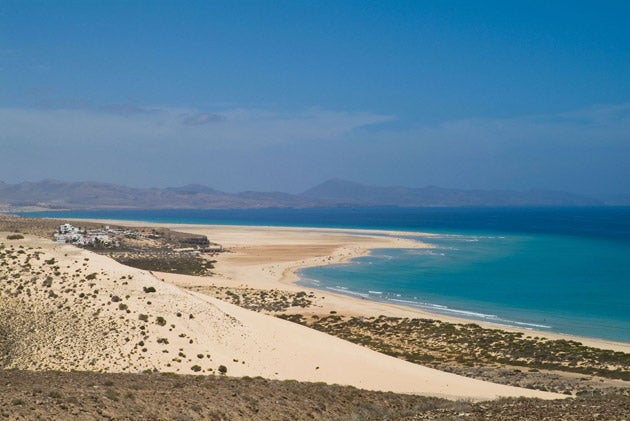The Independent's journalism is supported by our readers. When you purchase through links on our site, we may earn commission.
Seven islands, seven landscapes: The Canary Island's busy network of ferries offers the chance to see plenty of great sea life and shore-scapes

Your support helps us to tell the story
From reproductive rights to climate change to Big Tech, The Independent is on the ground when the story is developing. Whether it's investigating the financials of Elon Musk's pro-Trump PAC or producing our latest documentary, 'The A Word', which shines a light on the American women fighting for reproductive rights, we know how important it is to parse out the facts from the messaging.
At such a critical moment in US history, we need reporters on the ground. Your donation allows us to keep sending journalists to speak to both sides of the story.
The Independent is trusted by Americans across the entire political spectrum. And unlike many other quality news outlets, we choose not to lock Americans out of our reporting and analysis with paywalls. We believe quality journalism should be available to everyone, paid for by those who can afford it.
Your support makes all the difference.There are two essentials to island hopping, namely islands with enough contrast to warrant a hop, and an easy means of making such a hop. These days, it's easy to take in the multiple personalities of the Canary Islands in only a few short hops by hydrofoil and high-speed ferry.
Although the islands have an airport each, the ferry offers greater flexibility as well as the chance to absorb some amazing sights. If you want a little bit of everything, Tenerife is the Canary Island-hopper's catch-all – with Mount Teide dominating the landscape from every angle, the lush vineyards of La Orotava and the main tourist playgrounds of Costa Adeje and Los Cristianos. It's also the main hub of inter-island seaborne traffic, allowing access to all of the other islands either directly, or with just one change. The connections are made on large, modern ferries or fast catamarans from Los Cristianos or Santa Cruz.
Ferries are just part of the traffic in and out of the busy Las Palmas port in Gran Canaria. Cruise liners and ferries bring in almost a million passengers a year, and cargo ships glide out laden with tomatoes and bananas. From here, you can sail to Fuerteventura in three hours, home to more than 150 sub-tropical beaches of near-white sand and gin-clear ocean. Morro Jable is the island's southernmost port, and the gateway to the Jandía peninsula with its wild, wide swaths of sand and perfect windsurfing conditions.
Ferries from Gran Canaria also dock in Puerto del Rosario, half-an-hour's drive from Corralejo, the island's most popular resort. If you like the beach, it'll feel like Nirvana. If not, you'll need to move on. And that's easy: hop on a hydrofoil for half and hour to Lanzarote. The island presents a bucketful of drama. Over the years, natural pyrotechnics have created a landscape of volcanic cones, caves and cinders like nowhere else on Earth.
After such dry and harsh surroundings, an eyeful of greenery might be a welcome respite. The waters between Tenerife and La Gomera are home to one of the largest pods of pilot whales in any ocean. Whales and dolphins are frequently spotted racing alongside the ferries. By hydrofoil, La Gomera is half an hour from Tenerife. It's an island of ancient laurel forests and fishing villages that has been unchanged for centuries. La Palma, too, provides dense clusters of pines and palms, and precipitous ridges of volcanic cones.
Finally, five hours' sailing from Tenerife, the most western island of El Hierro offers arid plains of wind-twisted juniper trees and rolling tumbleweed. It might feel like you've reached the end of the world, but it's plain sailing back to civilisation on the network of ferry routes that unites all these very different seven sisters.
Travel essentials: Island hopping
Getting there
* The main airports in the Canaries served year-round from the UK are Tenerife South, Las Palmas (Gran Canaria), Arrecife (Lanzarote) and Fuerteventura. They have flights operated by a range of airlines, including easyJet (0905 821 0905; easyjet.com ), Monarch (0871 940 5040; flymonarch.com ), Ryanair (0871 246 0000; ryanair.com ), Thomas Cook (0871 230 2406; flythomascook.com ) and Thomson (0871 231 4787; thomson.co.uk ). In summer, there are also direct flights to La Palma, and in the near future the link with Tenerife North may be re-established.
* If you prefer to stick to a maritime journey, then the best approach is from Cadiz on the regular ferries of Acciona Trasmediterranea (00 34 902 454 645 trasmediterranea.es ).
Getting around
* La Palma, La Gomera and El Hierro have connecting flights, with local air links centred on Las Palmas. But for the best seaside experience, you can take advantage of the range of inter-island ferries. Acciona Trasmediterranea (00 34 902 454 645; trasmediterranea.es ) operates from Santa Cruz de Tenerife and sails to Arrecife, Fuerteventura, La Palma, Las Palmas and El Hierro. In addition, Fred Olsen ( fredolsen.es ; 00 34 902 100 107) sails from Santa Cruz de Tenerife to Las Palmas (the largest port in the Canaries) and Agaete on Gran Canaria, between Lanzarote and Fuerteventura, and from Los Cristianos to various points on La Gomera plus El Hierro. Naviera Armas (00 34 902 456 500; naviera-armas.com ) has a parallel comprehensive network of routes, with some interesting additions such as ferries from Madeira. The islands are also connected by some smaller ferry links, such as the launches linking Lanzarote's northern tip with Graciosa.
More information
Spanish Tourist Office: www.spain.info/uk
Turismo de Canarias: www.canarias.es
Join our commenting forum
Join thought-provoking conversations, follow other Independent readers and see their replies
Comments